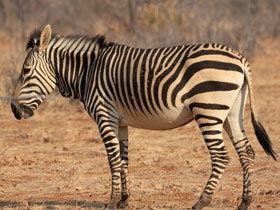The mountain zebra (Equus zebra)
 The mountain zebra (Equus zebra) is included in the IUCN Red List as a "vulnerable species"
The mountain zebra (Equus zebra) is included in the IUCN Red List as a "vulnerable species"
The mountain zebra (Equus zebra) is a zebra species in the family Equidae, native to southwestern Africa. There are two subspecies, the Cape mountain zebra (Equus zebra zebra zebra) found in South Africa and Hartmann's mountain zebra (Equus zebra hartmannae) found in south-western Angola and Namibia.
Taxonomy
The mountain zebra comprises two subspecies:
- Cape mountain zebra (Equus zebra zebra zebra).
- Hartmann's mountain zebra (Equus zebra hartmannae).
In 2004 C. P. Groves and C. H. Bell investigated the taxonomy of zebras (genus Equus, subgenus Hippotigris). They concluded that the Cape mountain zebra (Equus zebra zebra) and Hartmann's mountain zebra (Equus zebra hartmannea) are distinct, and suggested that the two are best classified as separate species, Equus zebra and Equus hartmannae.
However, in a sex genetic study involving 295 mountain zebra specimens, Moodley and Harley (2005) found nothing to support the separation of the two mountain zebra populations into separate species. They concluded that Cape mountain zebra and Hartmann's mountain zebra should remain as subspecies.
This is consistent with the third edition of Mammal Species of the World (2005), which lists the mountain zebra as a single species (Equus zebra) with two subspecies.
In relation to the other equids, a mitochondrial DNA study revealed that the mountain zebra is more closely related to the African wild ass (Equus africanus) than to the other zebras, although nuclear DNA analysis is needed to clarify the phylogenetic relationships between these species.
Appearance
Equus zebra is a species of perissodactyl mammal of the family Equidae native to southern Africa (Namibia and South Africa).
Equus zebra is a species of mammal in the ungulate family Equidae, the smallest of the zebra species.
The mountain zebra comprises two subspecies: Cape mountain zebra (Equus zebra zebra) and Hartmann's mountain zebra (Equus zebra hartmannae).
Equus zebra differs from Equus quagga burchellii in that it has wider black stripes and finer white spaces, making it appear darker. The "shadow stripes" of the common zebra are absent. On the legs, the stripes run down to the hooves. The Equus zebra weighs on average between 260 and 370 kg and is about 2.20 m long and between 1.2 and 1.5 m high at the withers. The Equus zebra is on average slightly larger and has finer black stripes than the mountain kappa zebra.
Distribution
The range of Equus zebra is much smaller than that of the burchell zebra. It is found on the mountain plateaus of Namibia and South Africa, at an altitude of up to 2,000m. Equus zebra are found in Namibia and Cape mountain zebra around the Cape of Good Hope.
Social behaviour
Equus zebra live in small groups that are not tied to their own range. These groups consist of one adult male, about five females and their cubs. Against other group leaders, the male can be quite aggressive. He leads his group for five to fifteen years before being displaced from his position by a younger rival.
Females may remain in the group all their lives, but if the group becomes too large, they may also split up. The leader of the splinter group is then taken over by the ascending male. In addition to family groups, there are also groups of young males who have not yet formed their own group. Older males driven out by younger males may also sometimes form splinter groups.
Threats to existence
The Cape mountain zebra (Equus zebra zebra) is extinct in all but a few protected areas and national parks (Cape of Good Hope, Bontebok, Karoo and Mountain Zebra National Park). Hunting was so intense that only 45 mountain zebras were recorded alive in South Africa when the population was counted in 1937. To save the subspecies, the Mountain Zebra National Park was established and now has 350 live mountain zebras. Approximately the same number of these animals live in other protected areas in South Africa. The IUCN classifies the Cape mountain zebra subspecies as endangered, but it is no longer considered directly threatened.
Although the situation is slightly better for Equus zebra hartmannae, its population has declined recently. In Namibia there are a total of 15,000 Equus zebra hartmannae, eight times less than at the beginning of the 20th century. The main reason for the population decline is culling by livestock farmers, who are trying to preserve pastures for their cattle. The IUCN already classifies the Equus zebra hartmannae as endangered.
















































